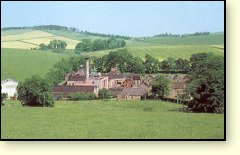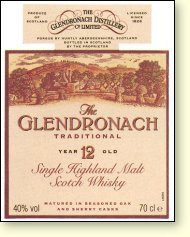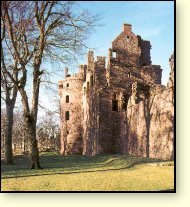
 |
|
Location: Forgue, Aberdeenshire AB54 6DB
Roads: On the B9001 off A97 Huntly-Banff
Hours: Tours at 10am and 2pm, Mon - Fri; by appointment only
Group bookings, max 100
Reception centre and shop
Phone: 01466 730202
Fax: 01466-730313
|
Text from The Whisky Trails, Copyright © Gordon Brown 1993:
The distillery is set among the gentle, green slopes of the Valley of Forgue in Aberdeenshire’s ‘castle country’. It is rural and peaceful although the colony of rooks in the great, mature trees around the distillery regularly create a breach of the peace. It was precisely such noisy commotion that made the rooks of 200 years ago useful allies of illicit distillers; they always gave warning of anyone, Excise officers included, who approached unannounced.
At Glendronach all of the auxiliary preparation for distilling continues to be done in the traditional ways – it has its own floor maltings and pagoda-headed malt-kiln. Fermentation vessels are still made of wood, the stills are coal-fired and the distillery even grows some of its own barley locally. The local lairds are the Dukes of Gordon and it was the 5th Duke who persuaded the London government that fair licensing was the best way to beat whisky smuggling.

|
The 1823 Excise Act was a direct result of his commonsense approach to the problem. The distillery was founded in 1826 by a consortium of farmers and businessmen. In 1881 it was acquired and enlarged by Walter Scott, who had worked at Teaninich for a while. In 1920, Charles Grant, son of the founder of Glenfiddich distillery, bought Glendronach and it remained in the Grant family until it was sold to Teacher in 1960.
The Dronac burn, whose name has been taken for the whisky and the distillery, flows through the grounds. With so many of the traditional practices still being followed and the buildings themselves so little changed, the ‘feel’ both inside and out is most satisfying. The earth floors in the warehouses hold moisture, absorbing some of the excess from the air in wet weather and releasing it during extended hot spells in summertime. The floor maltings are still in use and provide a proportion (about 15 per cent) of the malt needed for production. Glendronach is lightly peated. There are two pairs of stills, which are heated by naked flames from coal fires.
The water for production comes from local springs and barley is grown on the company’s own farms located in the district around the distillery.
The Whisky
Text from The Whisky Trails, Copyright © Gordon Brown 1993:
Glendronach used to be available in two official editions – the Original, from plain and sherry casks, and a 100 per cent sherry-aged version. There is now a single official edition – the Traditional, at 12 years old and 40/43% vol. – which seeks to combine the merits of both styles by changing the proportions previously used for the original. The new ‘recipe’ is still a sherried style but casks that have been filled once, or even twice, before with whisky are used to let other aromas and flavours come through the sherry.
Certainly, both the creamy oakiness and the toasty toffee of respectively plain and sherry casks now show distinctly, and the elegant malt and smoke that were common to both before shine through in excellent balance. Texture is big and smooth. Occasional official special editions are released, such as the recent 18-year-old (1972 vintage) and some 22-year-old is available from a private bottler.
The make is used in Teacher’s Highland Cream, a blend with an exceptionally high malt content, and others in the Allied Distillers range.
Source of water
Springs near Dronach Burn
Of interest
Text from The Whisky Trails, Copyright © Gordon Brown 1993:

The towering ruins of Huntly Castle, also known as the Palace of Strathbogie, retain some remarkable architectural details.
|
• Huntly Castle site has been fortified since the 1100s when a Norman peel was built on land gifted by William the Lion. Robert the Bruce occupied it in the years before Bannockburn. The present ruin dates from the 14th century and the entrance to the round tower has been described as ‘the most splendid heraldic doorway in the British Isles’.